Warm, creamy, and filling are the perfect words to describe this garlic white wine risotto. Creamy Arborio rice cooked with cashew cream and green peas makes for an incredible vegan meal. Let's learn how to make it!

Risotto has a reputation of being finicky and time-consuming. I'm very much hoping that this recipe for garlic white wine risotto proves otherwise!
While it may take a little while to simmer, you don't need standing over the stove for the entire time. This is the perfect multi-tasking recipe!
Creamy, cheesy rice mixed with green peas, fresh chives and plenty of garlic flavor - what more could you ask for in a vegan recipe?
If you're looking for more cozy dinners, be sure to try our pumpkin tomato soup or our roasted cauliflower gnocchi soup.

Ingredients
Here is your recipe shopping list:
- raw cashews: Base for a luscious vegan "cream." Once blended, cashews add a rich, velvety texture that mimics dairy without overpowering the flavor.
- vegetable broth: Provides moisture for cooking the rice while infusing it with savory depth.
- olive oil - Used to sauté the onion and garlic, adding richness and helping develop the aromatic base of the dish.
- onion: Builds savory flavor and subtle sweetness, forming the foundation of the risotto's depth.
- garlic: The star ingredient! Garlic gives the risotto its bold, comforting flavor and balances beautifully with the white wine.
- dried thyme: Adds a warm, earthy herbal note that complements the garlic and white wine.
- Arborio rice: A short-grain rice with a high starch content that's essential for the classic creamy risotto texture.
- dry white wine: Adds brightness, acidity, and complexity, cutting through the richness of the cashew cream.
- salt: Enhances all the other flavors and balances the creaminess of the dish.
- lemon juice: Adds a pop of acidity and freshness that lifts the entire dish.
- peas: Provide color, sweetness, and a pop of texture that contrasts the creamy rice.
- vegan parmesan cheese: Adds a salty, nutty flavor and a touch of umami, just like traditional parmesan would.
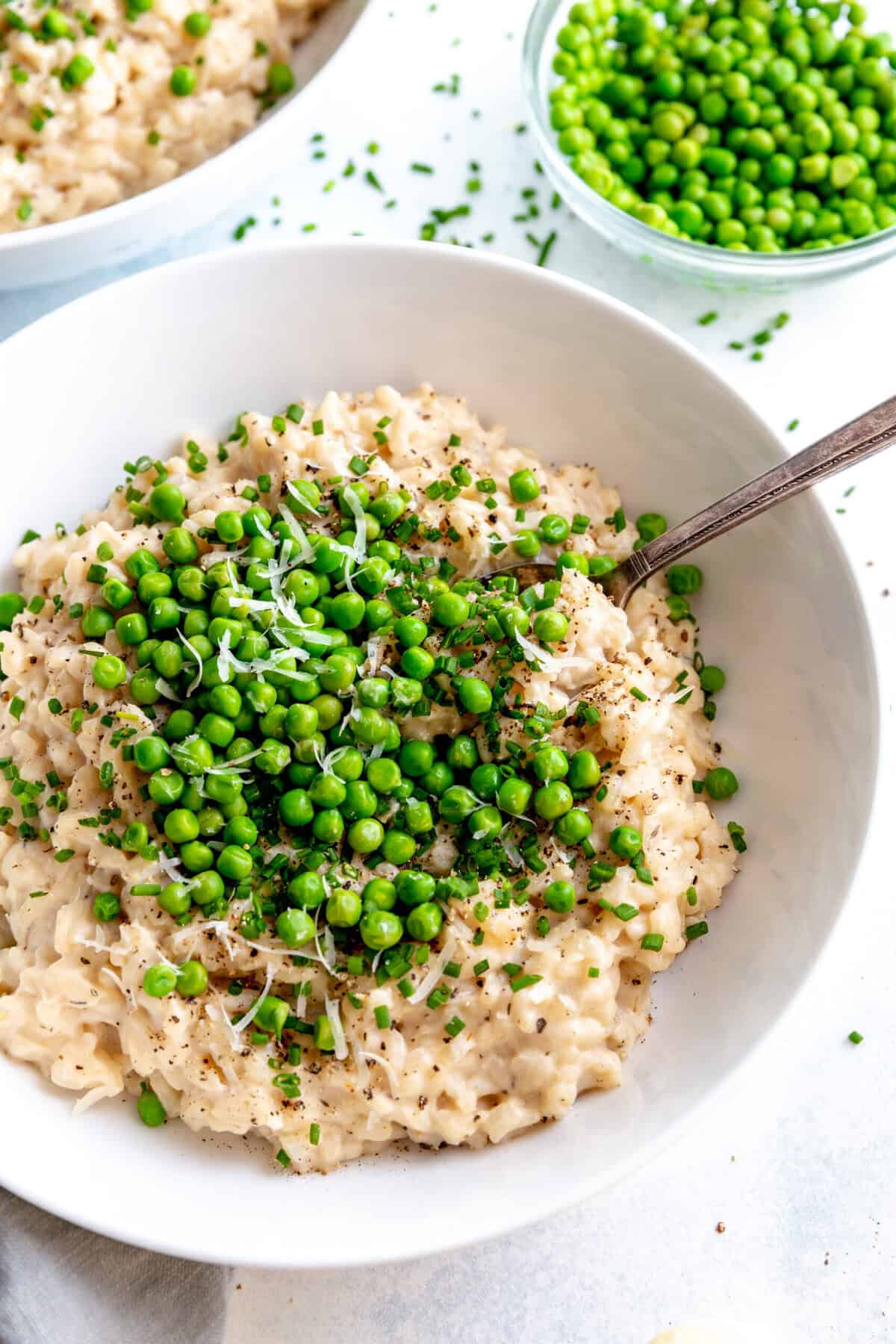
Why You'll Love This Recipe
- Creamy without the cream: Thanks to the cashew blend, you get all the rich, velvety texture of traditional risotto - completely dairy-free.
- Garlic lovers, rejoice: With eight cloves of garlic, this recipe is bursting with cozy, savory flavor in every bite.
- Elegant yet easy: It feels like a restaurant-quality meal but comes together in one pan with simple, wholesome ingredients.
- Comforting and fresh: Creamy risotto meets bright lemon, sweet peas, and aromatic thyme-making it feel both hearty and balanced.
- Fully vegan and satisfying: Proof that plant-based comfort food can be luxurious, flavorful, and deeply satisfying.
How to Make Garlic White Wine Risotto (with pictures!)
Please see the recipe card at the bottom of the page for full instructions and ingredient measurements.
Begin by blending the cashews and water in a high-speed blender until completely smooth. Set aside.
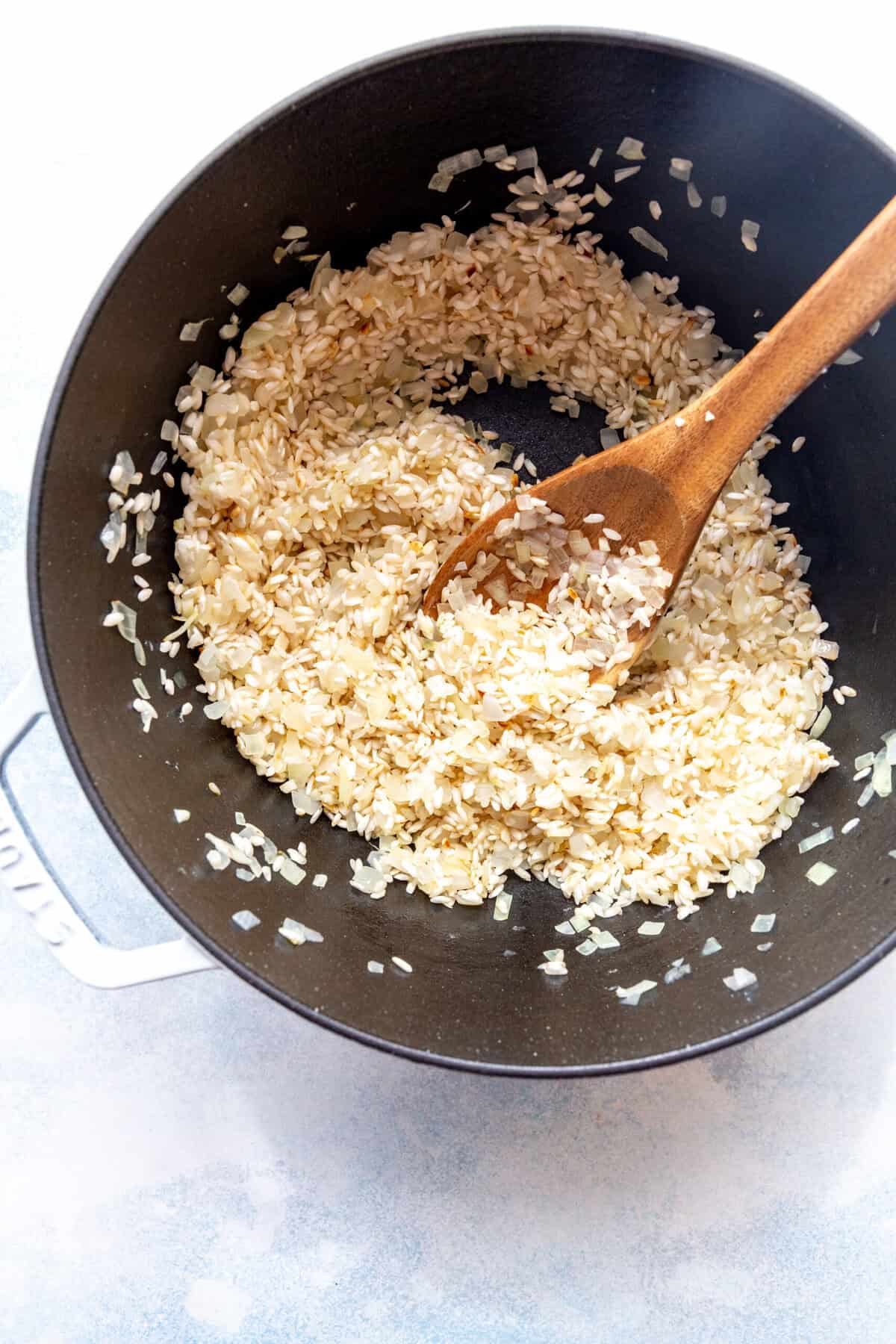
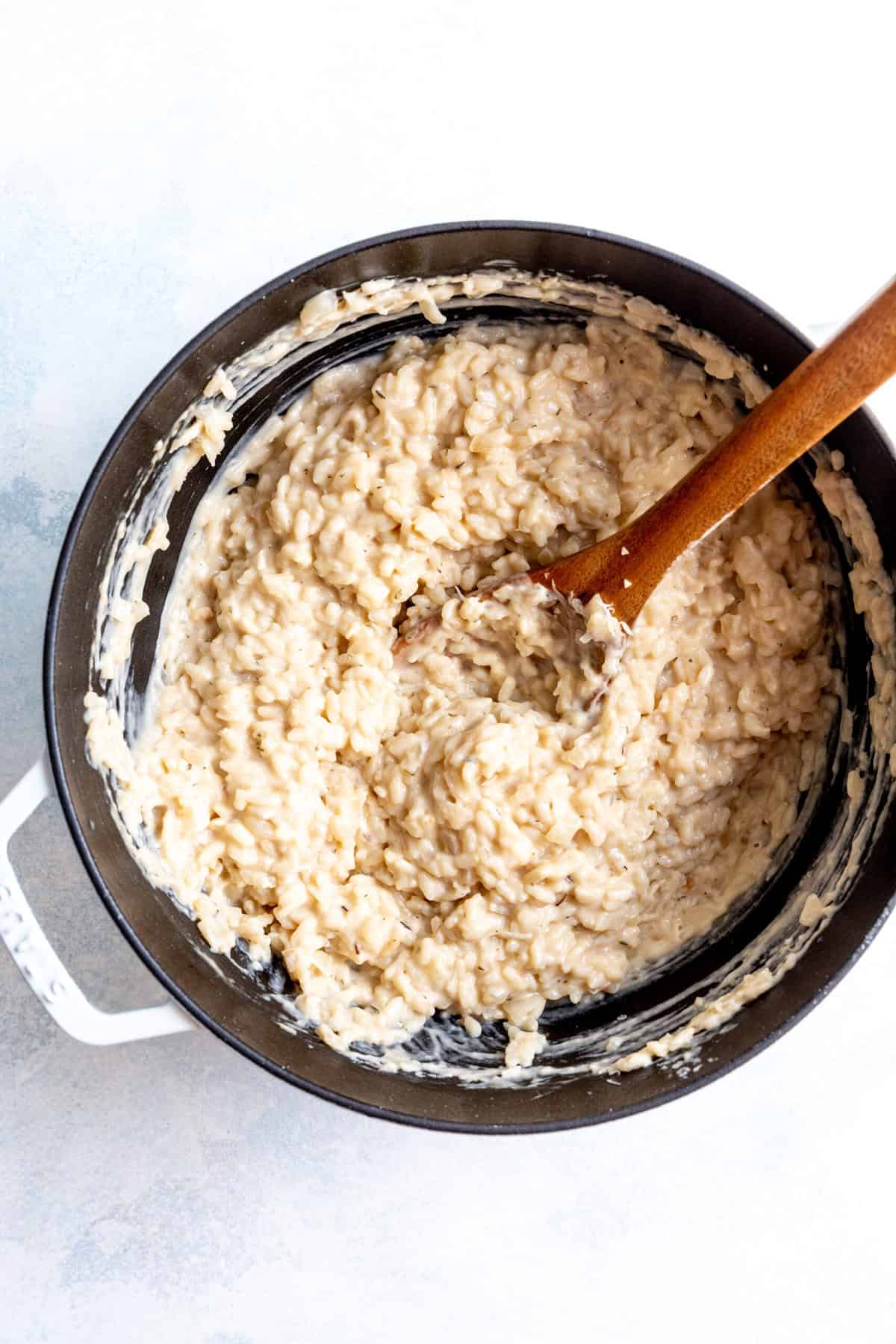
Place the vegetable broth in a saucepan on a small burner on the stove. Have it simmering on low as you start on your risotto.
Sauté the onion and garlic until soft. Add the rice to the pot and toast slightly. Pour in the white wine to deglaze the pan.
Begin adding the warm vegetable broth to the pot, one ladleful at a time. Wait until the broth is completely absorbed before adding another ladleful. Add the cashew cream with the final ladle of broth.
Stir in the peas and grate over the vegan parmesan cheese. Top with fresh chives and cracked black pepper.

Risotto Tips and Tricks
Here are some helpful tips for making the perfect risotto:
- Use Arborio rice: This short-grain rice is key to achieving that creamy, classic risotto texture. Regular rice just won't create the same luxurious consistency.
- Warm your broth: Add warm vegetable broth gradually as you cook-cold broth can slow down the process and affect texture.
- Stir often (but not constantly): Gentle stirring helps release the rice's natural starches, making your risotto creamy without overworking it.
- Don't rush it: Risotto is all about slow cooking and patience. Add broth one ladle at a time, letting it absorb fully before adding more.
- Adjust consistency at the end: Risotto should be creamy and slightly loose, not sticky or dry. Stir in a splash of broth or water if it thickens too much.
- Finish with freshness: The lemon juice, peas, and chives at the end brighten the whole dish and balance out the richness.
- Serve immediately: Risotto continues to thicken as it cools, so enjoy it hot and creamy right off the stove.

Common Mistakes & How to Fix Them
- Using the wrong rice:
- Mistake: Using long-grain rice like jasmine or basmati.
- Fix: Always use short-grain rice such as Arborio, Carnaroli, or Vialone Nano. These varieties release starch that gives risotto its creamy texture.
- Adding broth too quickly:
- Mistake: Pouring in too much broth at once.
- Fix: Add the broth one ladle at a time, stirring gently between additions. Let the rice absorb the liquid before adding more-this builds the creamy consistency gradually.
- Not warming the broth:
- Mistake: Adding cold broth directly to the rice.
- Fix: Keep your vegetable broth warm on a separate burner. Cold broth slows the cooking process and makes the texture uneven.
- Over- or under-stirring
- Mistake: Either stirring too much (making it gluey) or not enough (leaving it uneven).
- Fix: Stir frequently but gently-enough to keep the rice from sticking and to release starch, but not so much that it becomes mushy.
- Overcooking the rice
- Mistake: Cooking until the rice is soft all the way through.
- Fix: Risotto should be al dente-tender with a slight bite in the center. Start tasting a few minutes before the suggested cook time.
- Skipping the deglazing step
- Mistake: Not adding wine or adding it too late.
- Fix: After toasting the rice, add the white wine to deglaze the pan. It adds depth and removes any stuck bits for extra flavor.
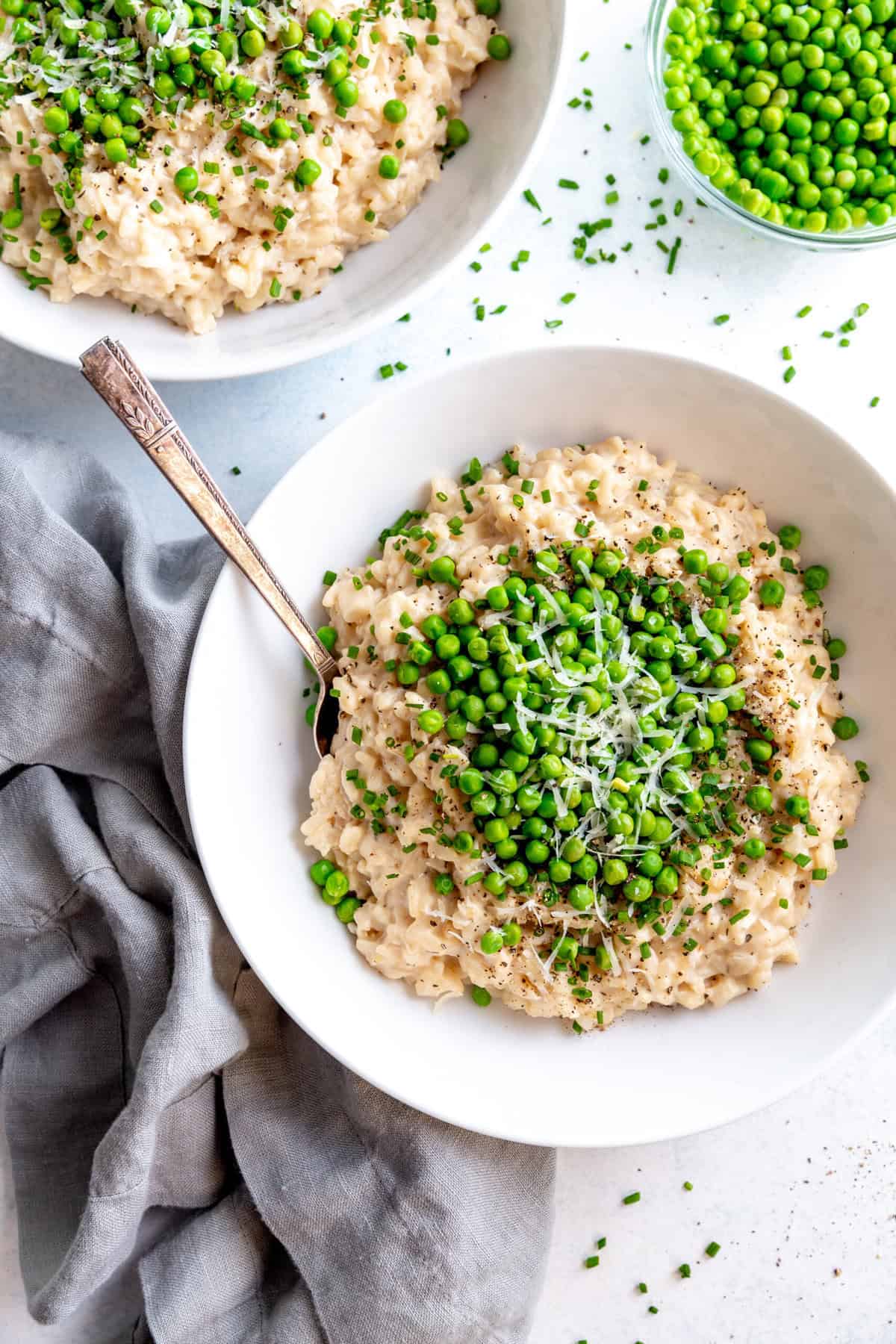
Frequently Asked Questions
Yes! You can substitute with unsweetened soy or oat cream. Cashews are ideal for their neutral, creamy texture.
White wine adds acidity and depth, but you can replace it with extra vegetable broth and a splash of lemon juice if you prefer alcohol-free.
The rice should be al dente-tender but with a slight bite in the center. The texture should be creamy, not dry or mushy.
You can make the risotto base ahead and reheat gently with a splash of broth before serving, but it's best served fresh for the classic creamy texture
Stirring gently, adding warm broth gradually, and finishing with the cashew cream will maximize creaminess. A touch of vegan butter or nutritional yeast at the end can also enhance richness.
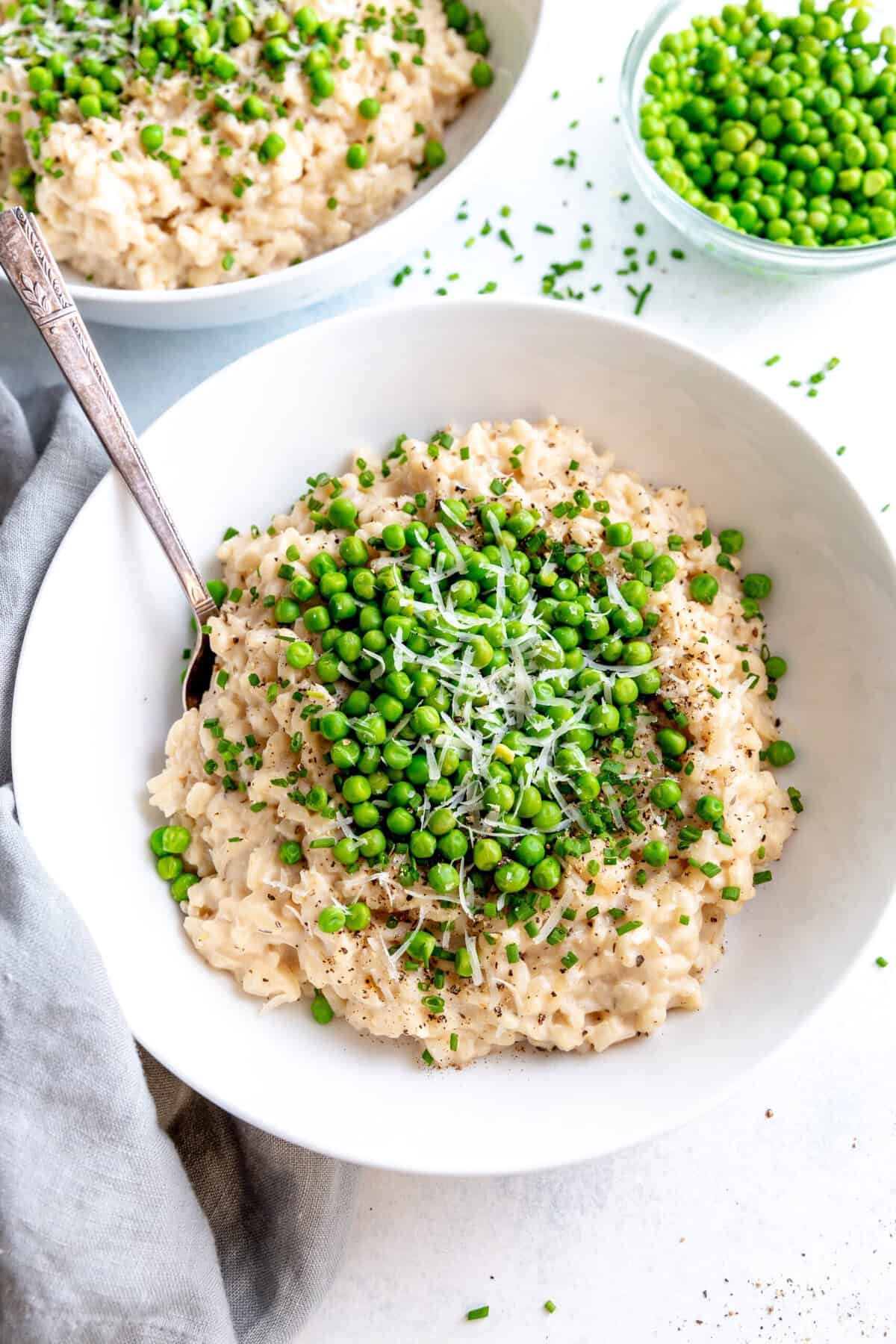
Recipe Variations
Here are a few ideas to help you jazz up your garlic white wine risotto:
- Mushroom & Thyme Risotto: Swap or add sliced cremini or shiitake mushrooms. Sauté them with the onion for an earthy, savory twist.
- Butternut Squash & Sage Risotto: Stir in roasted butternut squash cubes and fresh sage at the end for a sweet, autumnal version.
- Lemon & Asparagus Risotto: Add blanched asparagus tips and extra lemon zest for a bright, spring-inspired risotto.
- Spinach & Sun-Dried Tomato Risotto: Fold in fresh spinach leaves and chopped sun-dried tomatoes just before serving for a colorful, flavorful variation.
- Nutty & Cheesy Risotto: Sprinkle toasted pine nuts or walnuts on top, along with additional vegan parmesan, for extra crunch and richness.
- Creamy Coconut & Curry Risotto: Swap half of the cashew cream with coconut milk and stir in a pinch of curry powder for a subtly exotic flavor.
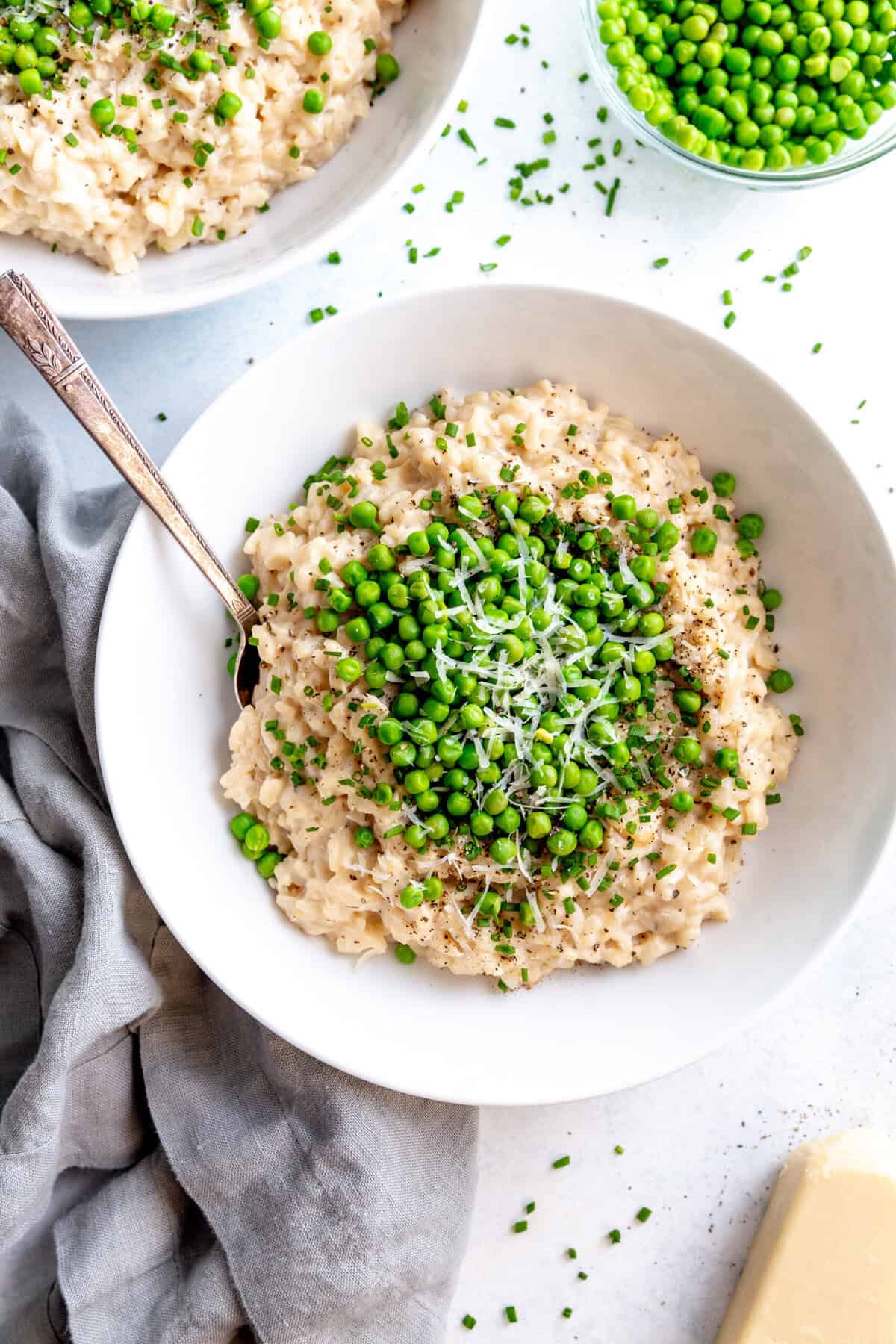
Storage and Leftovers
Storing
- Allow the risotto to cool to room temperature before storing.
- Transfer to an airtight container and refrigerate for up to 2-3 days.
- You can also freeze risotto in a freezer-safe container for up to 1 month, though the texture may be slightly softer upon thawing.
Reheating
- Stovetop method (recommended): Place the risotto in a pan over low to medium heat. Stir gently and add a splash of warm vegetable broth or water to restore creaminess.
- Microwave method: Heat in a microwave-safe dish in 30-60 second intervals, stirring in between and adding a little broth or nondairy milk if it seems too thick.
- Finish with a squeeze of lemon juice and a sprinkle of fresh chives to revive the bright, fresh flavors.
Tip: Risotto is always best freshly cooked, but careful reheating will bring back much of its creamy texture and flavor.
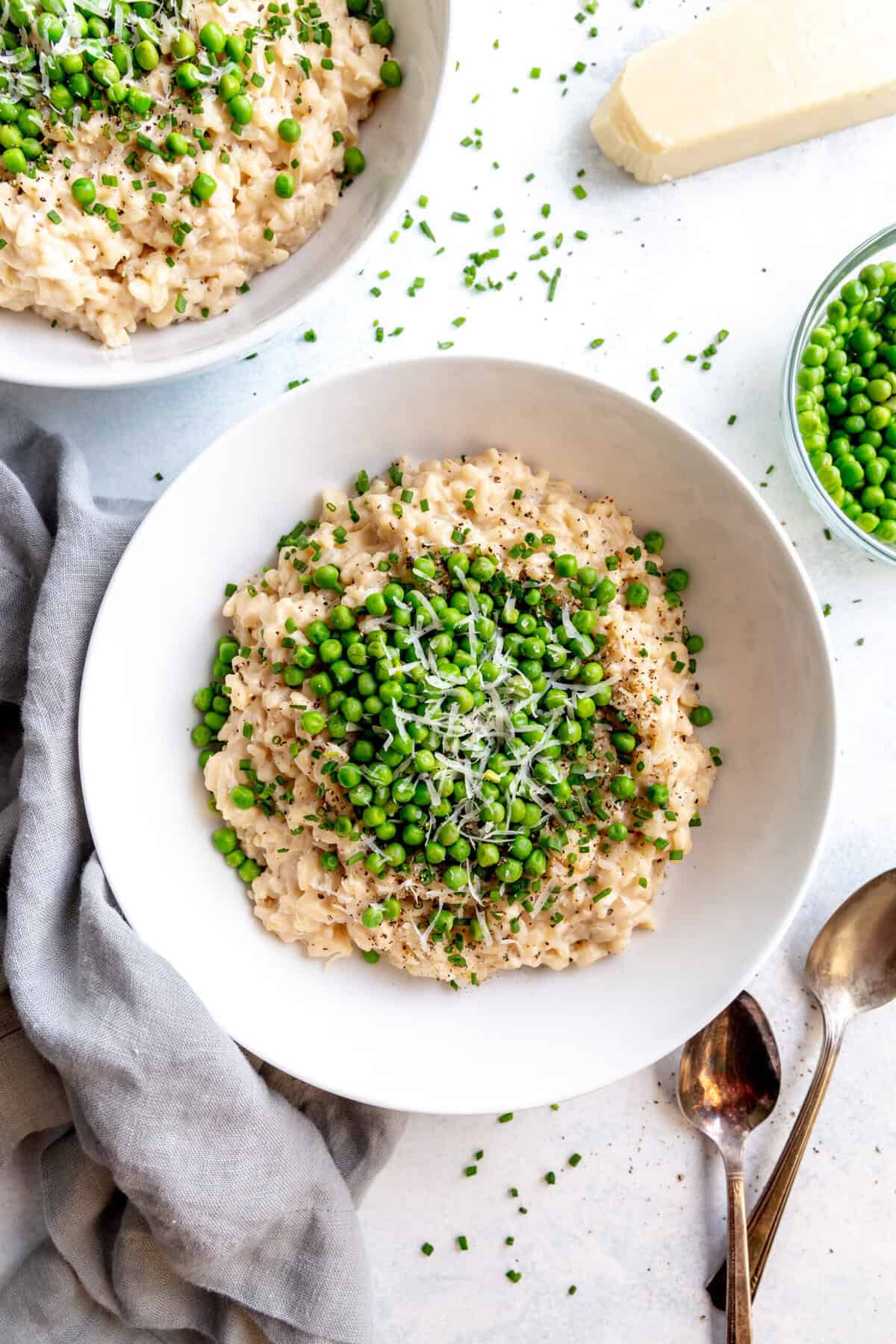
If you make this recipe please tag @censoredbaker on Instagram.
Garlic White Wine Risotto (Vegan)
Creamy, garlicky white wine risotto topped with peas and vegan parmesan cheese.
- Prep Time: 15 minutes
- Cook Time: 45 minutes
- Total Time: 1 hour
- Yield: 3 servings 1x
- Category: Rice
- Method: Stovetop
- Cuisine: Italian-Inspired
- Diet: Vegan
Ingredients
For the Risotto
½ cup raw cashews, soaked and drained*
1 cup water
4 cups vegetable broth
1 tablespoon olive oil
1 medium onion, chopped
8 cloves garlic, minced
1 teaspoon dried thyme
1 ½ cups Arborio rice
1 ½ cups dry white wine*
½ teaspoon salt
juice of half a lemon
1 cup peas (fresh or frozen)
For Topping
vegan parmesan cheese*
fresh chives for serving
cracked black pepper
Instructions
- Blend: Add the cashews and water to a high speed blender. Blend until completely smooth. This may take up to 5 minutes - allow your machine to rest intermittently to avoid over-heating.
- Warm: Pour all of the vegetable broth into a small saucepan. Place on a small stove burner and heat on low. Keep the broth warming here while you work.
- Sauté: Heat oil in a large pot over medium. Add the chopped onions to the pot along with the salt. Cook for 4-5 minutes or until soft. Stir in the garlic and dried thyme and cook for 1 more minute. Add rice to the pot and stir. Pour in the white wine and cook until all of the liquid has been absorbed by the rice.
- Simmer: Add warm vegetable broth to the rice, one ladleful at a time. Cook until the broth is absorbed, then add in another ladleful. Add in the cashew cream with your final label of broth. Cook until all of the liquid has been absorbed. Squeeze in the lemon juice and grate in a little vegan parmesan cheese. Add more salt to taste. Stir in the peas and cook until heated through, about two minutes.
- Serve: Portion risotto into bowls and top with chopped chives and cracked pepper just before serving. Extra parmesan is also always a good idea!
Notes
*Cooked risotto will keep in the refrigerator for 2-3 days or can be frozen for up to 1 month.
*You can either soak your cashews overnight or pour boiling water over the top and soak for 2 hours.
*You can use any dry white wine you like! I prefer pinot grigio, chardonnay, or sauvignon blanc. No need to spend a lot of money here! Get something cheap.
*Vegan parm is totally optional! I really like the Violife block.
*When cooking risotto, it's really important to keep all of your liquids warm. Let your broth simmer on the stove while you work, and keep it simmering as you begin to ladle it into your rice.
*Risotto requires a certain level of patience but I promise it is so worth it! Just keep simmering!
Nutrition
- Serving Size: ⅓ recipe
- Calories: 512k
- Sugar: 5.4g
- Sodium: 850mg
- Fat: 21g
- Saturated Fat: 3.5g
- Unsaturated Fat: 17.5g
- Trans Fat: 0g
- Carbohydrates: 60g
- Fiber: 4.3g
- Protein: 10.5g
- Cholesterol: 0mg
More cozy vegan dinner recipes:
- roasted sweet potato salad
- pumpkin tomato soup
- roasted cauliflower gnocchi soup
- roasted autumn veggie pizza




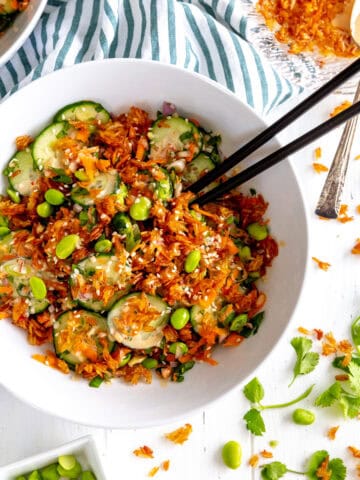
Leave a Reply